Efficiency in inventory tracking and product management is crucial for industries that depend on speed, such as retail and logistics. Businesses often find themselves choosing between two key technologies: barcodes and radio frequency identification (RFID). Each system offers unique advantages, yet both have their limitations.
In this article, we compare the core differences between RFID and barcodes, explore their respective advantages and disadvantages, and demonstrate how modern barcode scanner software addresses many of the shortcomings typically associated with barcode readers to enhance scanning performance.
Barcode technology: A cost-effective standard
Barcodes have been a cornerstone in inventory management since the 1970s, offering a cost-effective and straightforward solution for product tracking. A barcode is a machine-readable representation of data in a visual format, typically read by optical scanners. The simplicity and widespread adoption of barcodes make them a reliable choice for businesses of all sizes.
Benefits of barcodes
- Low-cost implementation: Barcodes are inexpensive to produce, with the costs associated mostly with printing and applying the labels. This low-cost factor makes barcodes an ideal solution for small to medium-sized businesses looking to manage inventory on a budget.
- Widespread usage: The universality of barcodes ensures compatibility with most global retail and logistics systems. This widespread adoption means businesses can integrate barcode technology without significant infrastructure changes.
- Ease of use: Most businesses already have the necessary infrastructure—barcode scanners, printers, and point-of-sale systems—making barcodes simple to implement and manage.
Limitations of barcodes
- Line-of-sight requirement: One of the key drawbacks of barcodes is the need for direct line-of-sight between the barcode and the scanner. This may slow down processes in high-volume scanning cases and environments where items are stored in hard-to-reach locations.
- Limited data capacity: Barcodes can only store certain types of information. For additional product details or data, the barcode must be linked to an external database, e.g., using the GS1 Digital Link.
- Damage-prone labels: Barcode labels are susceptible to wear and tear, which can lead to scanning issues. Scanning errors or delays may occur if a barcode is damaged, scratched, or covered by dirt.
RFID technology: A modern solution
RFID, which has been around commercially almost as long as barcodes, uses electromagnetic fields to automatically identify and track tags attached to objects. RFID systems do not require direct line-of-sight, allowing for the simultaneous scanning of multiple items. This makes RFID a powerful tool for large-scale logistics and supply chain management.
Benefits of RFID
- No line-of-sight required: RFID tags can be scanned from a distance and through various materials, such as packaging. This speeds up inventory management in high-volume or complex environments.
- Enhanced data capacity: RFID tags can store product details, manufacturing dates, and shipping histories. Moreover, the data on RFID tags can be modified or updated throughout the supply chain.
- Simultaneous scanning: RFID systems can scan multiple items at once, improving speed and efficiency in environments with large quantities of items, such as warehouses and distribution centers.
- Durability: RFID tags are generally more durable than barcode labels, as they are less prone to physical damage from environmental factors such as moisture, heat, or abrasion.
Limitations of RFID
- Higher cost: The primary disadvantage of RFID is the cost. RFID tags, readers, and their system setup are significantly more expensive than traditional barcode technology, which can be prohibitive for smaller businesses.
- Signal interference: RFID signals are sometimes disrupted by materials like metal or liquids, reducing the reliability of readings. Additionally, signal interference from other electronic devices can affect the accuracy of scans.
- Privacy concerns: RFID tags can be scanned remotely, even when not in direct view, raising concerns about unauthorized access to data and potential privacy issues.
Enhancing barcode scanning with modern barcode scanner software
While barcodes offer a cost-effective and reliable solution, they do have limitations, particularly in terms of line-of-sight requirements, data capacity, and vulnerability to damage. RFID may offer enhanced data capacity, speed, and durability, but implementing the technology has high costs and reliability issues.
Modern barcode scanner software like the Scanbot Barcode Scanner SDK addresses many of the shortcomings of traditional barcode readers, making barcodes a more competitive option when compared to RFID for certain use cases.
- Overcoming line-of-sight challenges: One of the key drawbacks of barcodes is the need for direct line-of-sight scanning. The Scanbot Barcode Scanner SDK enhances scanning speed and accuracy, even when barcodes are at awkward angles or partially obscured. It also supports scanning multiple barcodes in one frame, increasing efficiency in inventory management processes.
- High-speed scanning: The Scanbot SDK enables rapid scanning, which is crucial for high-volume environments. With advanced scanning algorithms, it can process barcodes swiftly, reducing the time required to scan each product manually.
- Improved damage tolerance: The Scanbot SDK features enhanced barcode recognition, accurately scanning even damaged, distorted, or poorly lit barcodes. This feature mitigates the common issue of barcode labels becoming unreadable due to wear and tear, a major challenge in high-traffic logistics operations.
- Broad device compatibility: Unlike traditional barcode scanners, which require specialized hardware, the Scanbot Barcode Scanner SDK is designed to run on most smartphones and tablets. This reduces the need to invest in dedicated scanning hardware, making barcode technology more accessible and cost-effective.
- Enhanced data handling: Although barcodes have limited data capacity, the Scanbot Barcode Scanner SDK can quickly link scanned barcodes to robust backend systems where detailed product data can be stored, managed, and analyzed. This allows businesses to use barcodes as an entry point for accessing comprehensive data on each item.
Choosing the right solution: RFID or barcodes?
While RFID offers advantages for large-scale, high-efficiency environments, modern barcode scanner software such as the Scanbot Barcode Scanner SDK makes traditional barcode scanning gain a competitive advantage. By addressing key limitations – such as line-of-sight requirements, scanning speed, and damage tolerance – the Scanbot SDK enables businesses to extend the life and capabilities of their existing barcode systems without the need for costly RFID implementations.







